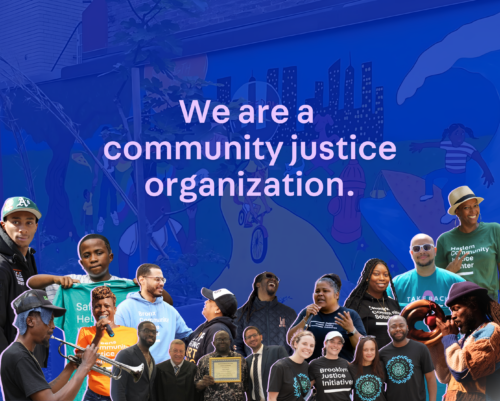To achieve true justice, we must build safety. And for communities to feel truly safe, there must be justice.
For far too long—and especially in recent years—we’ve been told that we must choose between justice and safety, that those two ideals are in direct competition. But the reality is that to achieve true justice, we must build safety. And for communities to feel truly safe, there must be justice.
This false dichotomy has ripped a hole in our politics and led to a seemingly endless cycle of extremist approaches to both justice and safety.
Communities deserve better. At the Center for Justice Innovation, our work over three decades has shown conclusively that communities are at the heart of delivering both justice and safety.
We call this approach “Community Justice.”
Community Justice seeks to reclaim and reimagine the very concept of the justice system. Rather than focusing exclusively on traditional system actors like courts and police—or, as we’ve seen in recent years, expecting local community groups to deliver safety and justice on their own—we see “the justice system” as encompassing all of the above.
Community Justice is a full-spectrum approach that runs from communities to systems and back again—whether that’s community-based programs that help young people imagine more for their futures or court-based programs that help people ensnared in the criminal legal system build stronger, more sustainable lives for themselves and their families.
From our very first community court in Midtown Manhattan to our work with public housing residents in Red Hook, Brooklyn, young people in the Bronx, and people charged with crimes in courts across New York City and across the country, we have always believed that sustainable solutions must center safety and racial justice—and be built in partnership with communities, courts, and the people most impacted.
For us, the “community” in Community Justice starts with the people who live and work in the neighborhoods we serve. But community is much bigger than that. It includes local businesses and entrepreneurs; grassroots and nonprofit organizations; system actors like public housing authorities, social service agencies, victim services, children’s services, and drug and mental health treatment providers; and legal system leaders like judges, prosecutors, defenders, civil attorneys, pretrial services, community corrections, law enforcement agencies, and criminal, housing, and family court administrators.
It takes everyone at the table to build strong, thriving, safe communities.
That’s why back in the early 1990s we put “community” in the heart of our very first program—the Midtown Community Court, now called the Midtown Community Justice Center, which we created in partnership with the New York State court system. When I was working at the Center as an entry-level associate in those early days, I saw firsthand how unique it was for a court to invite local residents, business owners, neighborhood nonprofits, and people with lived experience in the justice system inside the courthouse to identify priorities, brainstorm new approaches to local challenges, and volunteer to actually build the solutions together.
Since then, our work with communities has only deepened. We no longer merely consult with community members but engage them as full partners to build equitable, holistic solutions that meet people’s needs by preventing harm, reducing system involvement, and improving overall community health.
Our Community Justice orientation ensures new programs address real needs, rather than needs identified by remote officials, who may lack a full understanding of local culture and priorities. It builds leadership capacity and meaningful resources in neighborhoods harmed by historic disinvestment and, often, racial injustice. It strengthens local infrastructure, increasing the likelihood that those who live, work, and invest in these communities can launch and sustain their own new initiatives. And it builds bridges between communities and government, ensuring local voices are at the table when decisions are made that impact them.
Community Justice isn’t just an approach or tactic. It forms the core of who we are and what we do.
Across the Center, we work to build Community Justice every day. By definition, that work looks a little (or a lot) different from neighborhood to neighborhood or courtroom to courtroom:
- We reduce incarceration by supporting community-based forms of accountability that set people up for healthier lives.
- We address the underlying needs and social conditions—like lack of opportunity, mental health challenges, trauma, and housing insecurity—that bring people into the legal system.
- We engage community members and people with lived experience in conducting research on issues that affect them and implementing new, better approaches.
- We promote transparency, respect, and communication in the courtroom to deepen the connection between legal systems and the communities they serve.
- We invest in resident-led initiatives to revitalize public spaces, build safety and community, and foster economic mobility.
One of the best parts about Community Justice is that we don’t own this idea! It’s not an approach that can only work for just the Center for Justice Innovation or our partners. It’s an idea that can work for any community, which is why we work tirelessly to help people across the country and beyond apply a Community Justice lens to addressing their local challenges.
Community Justice is at the heart of everything we do at the Center—and we believe it can be the foundation of building truly just, thriving, safe communities across the globe.
